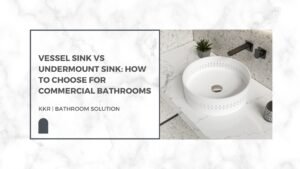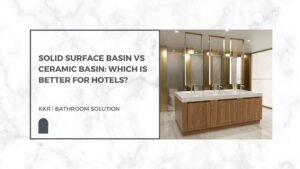Over time, even high-quality solid surface countertops can develop yellow glue lines along the seam areas. This discoloration not only affects aesthetics but can also reduce perceived cleanliness in high-end bathrooms. The issue is common in older installations or under long-term exposure to heat, UV light, or improper adhesive use.
This article provides a professional restoration guide for eliminating yellowing at the joints of bathroom basins and countertops, following factory-proven techniques from Kingkonree (KKR®) to ensure long-lasting results.
Why Glue Joints Turn Yellow
- Improper Adhesive Formula – Low-quality or mismatched glue may oxidize and discolor under sunlight or moisture.
- UV Exposure – Continuous exposure to sunlight or strong lighting accelerates chemical yellowing.
- Excess Glue Residue – Over-applied adhesive may not cure evenly, trapping impurities that later turn yellow.
- Moisture Penetration – Poor sealing allows water infiltration, reacting with the adhesive over time.
Step-by-Step Process: Removing Yellow Glue Marks
1. Identify and Prepare the Area
Inspect the affected joint to determine the yellowed zone. Clean the area thoroughly with neutral detergent to remove dirt and wax residues.


2. Machine a Shallow Channel
Using a precision router or hand grinder, create a narrow groove along the discolored joint line. This removes the surface yellowing and creates a clean space for re-bonding.


3. Refill with Fresh Solid Surface Adhesive
Mix the color-matched solid surface glue corresponding to the countertop color. Gently inject the new adhesive into the prepared channel to fill it completely.
Ensure uniform filling without air bubbles.


4. Allow Full Curing
Let the adhesive cure naturally at room temperature. Do not polish or sand until fully hardened, ensuring the new joint is structurally stable.


5. Sand and Polish the Seam
After the glue cures, sand the repaired area in stages using 240–400 grit sandpaper, followed by fine polishing until the joint’s color matches the surrounding surface.
Finish with a soft cloth to remove any residue and restore smoothness.


Preventing Future Yellowing
- Use high-quality UV-resistant adhesive specifically designed for solid surface materials.
- Avoid direct sunlight on joints by installing UV-protective films near windows.
- Clean regularly with non-abrasive neutral cleaners.
- Maintain stable temperature and humidity to slow chemical reactions in adhesives.
Why Choose KKR® for Solid Surface Countertops
KKR® utilizes advanced adhesive technology with high UV stability and color consistency to minimize yellowing over time. Each joint is seamlessly bonded, ensuring:
- Color-matched seams invisible to the eye.
- Long-term resistance to discoloration.
- Simple refinishing if maintenance is ever required.
With proper care, your solid surface countertop will maintain a fresh, uniform appearance for many years.




